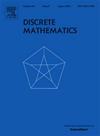Asymmetry of 2-step transit probabilities in 2-coloured regular graphs
IF 0.7
3区 数学
Q2 MATHEMATICS
引用次数: 0
Abstract
Suppose that the vertices of a regular graph are coloured red and blue with an equal number of each (we call this a balanced colouring). Since the graph is undirected, the number of edges from a red vertex to a blue vertex is clearly the same as the number of edges from a blue vertex to a red vertex. However, if instead of edges we count walks of length 2 which do not stay within their starting colour class, then this symmetry disappears. Our aim in this paper is to investigate how extreme this asymmetry can be.
Our main question is: Given a d-regular graph, for which pairs is there a balanced colouring for which the probability that a random walk starting from a red vertex stays within the red class for at least 2 steps is x, and the corresponding probability for blue is y?
Our most general result is that for any d-regular graph, these pairs lie within the convex hull of the 2d points .
Our main focus is the torus for which we prove both sharper bounds and existence results via constructions. In particular, for the 2-dimensional torus we show that asymptotically the region in which these pairs of probabilities can lie is exactly the convex hull of:
二色正则图中两步穿越概率的不对称性
假设一个正则图的顶点被涂成红色和蓝色,每个顶点的数量相等(我们称之为平衡着色)。由于图是无向的,从红色顶点到蓝色顶点的边数显然与从蓝色顶点到红色顶点的边数相同。然而,如果我们计算的不是边,而是长度为2且不停留在起始颜色类内的行走,那么这种对称性就消失了。我们在本文中的目的是研究这种不对称有多极端。我们的主要问题是:给定一个d正则图,对于哪些对(x,y)∈[0,1]2,是否存在一个平衡的着色,其中从红色顶点开始的随机行走在红色类中停留至少2步的概率为x,而蓝色的相应概率为y?我们最一般的结果是,对于任何d正则图,这些对位于2d点{(ld,l2d2),(l2d2,ld):0≤l≤d}的凸包内。我们的主要焦点是环面,我们通过构造证明了更尖锐的界限和存在性结果。特别地,对于二维环面,我们证明了这些概率对所能存在的渐近区域正是{(0,0),(12,14),(34,916),(14,12),(916,34),(1,1)}的凸包。
本文章由计算机程序翻译,如有差异,请以英文原文为准。
求助全文
约1分钟内获得全文
求助全文
来源期刊

Discrete Mathematics
数学-数学
CiteScore
1.50
自引率
12.50%
发文量
424
审稿时长
6 months
期刊介绍:
Discrete Mathematics provides a common forum for significant research in many areas of discrete mathematics and combinatorics. Among the fields covered by Discrete Mathematics are graph and hypergraph theory, enumeration, coding theory, block designs, the combinatorics of partially ordered sets, extremal set theory, matroid theory, algebraic combinatorics, discrete geometry, matrices, and discrete probability theory.
Items in the journal include research articles (Contributions or Notes, depending on length) and survey/expository articles (Perspectives). Efforts are made to process the submission of Notes (short articles) quickly. The Perspectives section features expository articles accessible to a broad audience that cast new light or present unifying points of view on well-known or insufficiently-known topics.
 求助内容:
求助内容: 应助结果提醒方式:
应助结果提醒方式:


